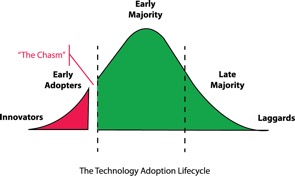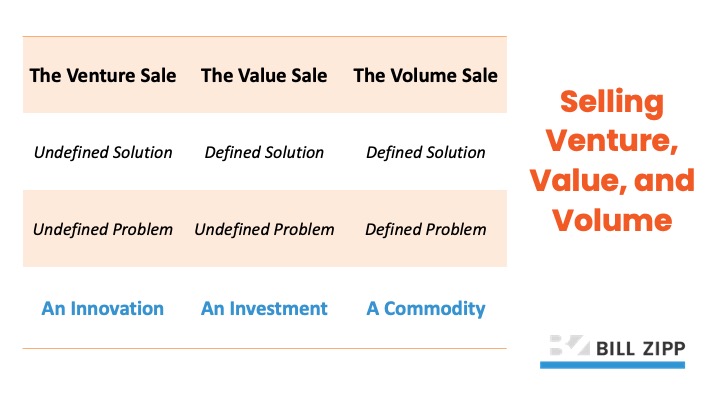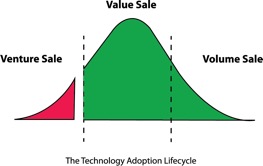When I was the head of sales for a group of radio stations, I had a salesperson who possessed a talent no one else on our sales team possessed. He could sell nothing.
Don’t get me wrong. He was one of the top producers in the company. By “nothing,” I mean that he had a unique ability to sell products that did not yet exist.
For example, to increase the revenue of one of our AM stations, we came up with the idea of publishing a directory with all the services available for seniors in our state, this station’s core demographic. Existing advertisers would be able to buy print ads in the directory to enhance their on-air presence, and advertisers who didn’t use radio would be enticed from running ads in the newspaper.
The problem was, the Senior Services Directory (as we came to call it) didn’t exist, and advertising needed to be sold before it existed to make it even a possibility. I sat down with this uniquely gifted salesperson and sketched out a sample directory on a napkin. True story—a napkin—and he sold out the first issue within a few months.
I don’t know how he did it, but he did it. After the first issue was printed, the rest of the sales team got into the action, and the product became a reliable source of revenue for years to come. Apart from this rep, however, it would have never happened.
This is what I call selling across the chasm.
The Technology Adoption Lifecycle
Most of us are familiar with Geoffrey Moore’s work on the technology adoption lifecycle from his seminal book, Crossing the Chasm. The lifecycle looks like this:

On the left of Moore’s bell curve is immediate market adoption of a new product or service by Innovators and Early Adopters. In the middle of the bell curve is mainstream adoption of a more developed product or service by the Early Majority. On the right of the bell curve is late adoption of a mature product or service by the Late Majority and so-called Laggards.
Slicing through the first third of this bell curve is a chasm that drops into what Moore calls the Valley of Doom. Many products never cross that chasm and fall to their deaths in the Valley of Doom. Innovators and Early Adopters love them, but they don’t catch on with anyone else and are a commercial failure. Crossing the chasm is the ultimate challenge most innovations face.
One of the reasons for death in the Valley of Doom is the inability of a traditional sales force to sell across the chasm. There are three keys to doing that, but first, let’s look at three kinds of sales that align with this lifecycle.
Selling Venture, Value, and Volume
The technology adoption bell curve has three distinct kinds of sales associated with it that parallel the categories above. There’s the sale of a product when it’s first introduced to the marketplace until it crosses the chasm into the mainstream. There’s the sale of a product when a product is in the center of the bell curve embraced by the Early Majority. And then there’s the sale of a product to the Late Majority and Laggards when it’s not new anymore and becomes a commodity. These three, respectively, are The Venture Sale, The Value Sale, and The Volume Sale.
The Venture Sale
The Venture Sale aligns with the technology adoption bell curve from its entry into the market until the point where it comes to the edge of the chasm. It offers customers an undefined solution for an undefined problem. Not that it brings an empty hand to the table. The Venture Sale has something good to offer, but it’s not sure exactly what all of that good is yet and provides its solution with an open hand.
A prospective customer receives this undefined solution with an open hand themselves. They, too, see the value of the innovation, and they, too, are not quite sure about all the ways in which it will benefit them. But they’re willing to spend their time and money to find out. An evolution of both the solution and the problem takes place through ongoing buyer-seller interactions, as both parties embrace a fair degree of risk.
The Value Sale
Once a product has been in the marketplace for a while, it develops into something that brings clear value to customers. While the Value Sale is a more defined solution, it’s still a fairly new solution, and the problem it solves is not yet fully understood by the buyer. So sellers have the job of learning buyers’ businesses in this area, even better than buyers know it themselves, and educating them as to why investing in this solution makes good financial sense.

This is the role of the Challenger Seller, a concept pioneered by the bestselling book, The Challenger Sale. Challenger sellers teach, tailor, and take control of the sales conversation, communicating to the buyer two things: the problem they have and how their product provides a solution to that problem.
The Volume Sale
A mature product brings to the marketplace a defined solution for a defined problem. The peak of the innovation curve has passed and companies seek to sell as much of an item as possible, squeezing the last ounce of profit from their investment. Margins are slim and competition is fierce.

This is transactional selling, a true numbers game. Don’t dismiss the Volume Sale, however, because it’s transactional. There’s lots and lots of money to be made with a commodity, just ask Costco, Amazon, or Toyota. It’s just a different kind of purchase than the previous two and is primarily price-driven.
Three Keys to Crossing the Chasm
A salesperson skilled at the Venture Sale has a unique set of gifts and abilities not usually found in traditional sellers. Here are three:
1. Visionary Intuition
The first skill for selling across the chasm is visionary intuition. What I mean by that is salespeople with this skill get it and get it in their gut, not relying on objective information to assess the impact of a new product.
Not that relying on objective information is wrong; it just doesn’t work for a Venture Sale because data like that doesn’t exist. Venture sellers instinctively grasp the power of an innovative idea and doesn’t need research to prove it to themselves (or others). These sales professionals see a future others can’t see, and the future looks bright.
2. Relational Acumen
The people savvy it takes in selling across the chasm is extraordinary. There is the relationship the seller has with the buyer. Not just one buyer, however, but many buyers in many parts of the business. Disruptive innovations are never bought by a sole purchasing agent sitting in a solitary cubicle. They’re bought by a group of people, so blame can be spread (like manure) if the product doesn’t work out.
One successful venture salesperson explains, “You must have the knowledge and time to invest in deep-dive conversations with prospects. Let’s not be fooled. It takes a lot of effort to gain confidence and trust, learn and understand the nuances of the issues at hand, and craft an intelligent, thorough, and actionable plan.”
Then there are the relationships a seller must maintain within the company he or she serves. Not just one relationship but, again, many in many parts of the business. Managing this list of internal and external stakeholders is infinitely more complicated than the usual list of decision makers a seller must manage and, consequently, requires deep relational acumen.
3. Comfort with Ambiguity
A third quality needed in selling across the chasm is comfort with ambiguity. At this stage of innovation, lots of things are up in the air. Product development is still in flux and may move in one direction one day and a completely different direction the next. Sellers who need every i dotted and every t crossed will not do well in this environment. Extreme flexibility, without the loss of integrity, is critical for success.
The innovative product you’re bringing to market may be more than a rough drawing on a napkin but perhaps not much more. To succeed at crossing the chasm as a sales professional, expand your visionary intuition, deepen your relational acumen, and learn how to be comfortable not dotting every i and crossing every t as development remains in flux.
With these, you will do well and avoid the Valley of Doom.


